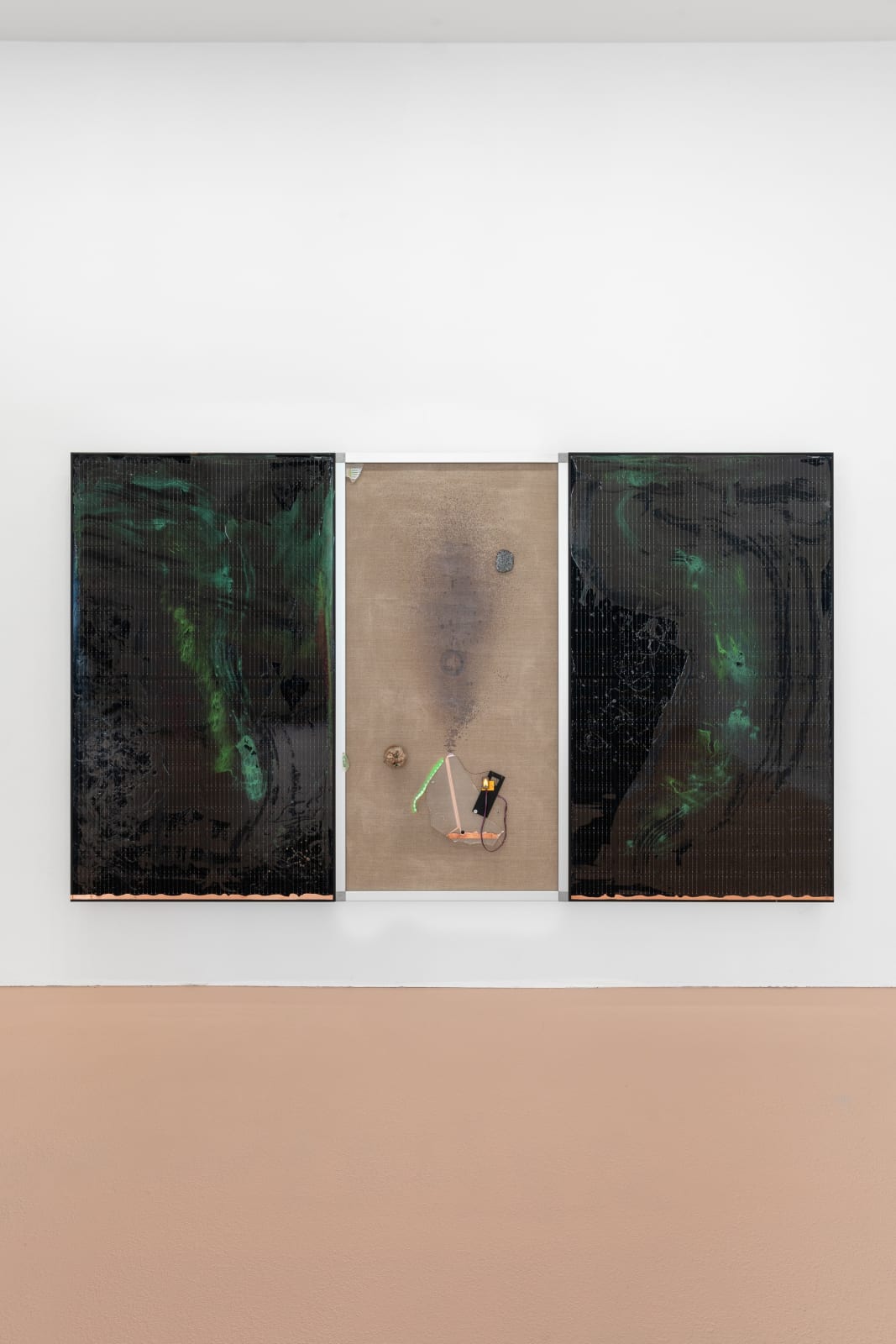-
artworks
Haroon Mirza
After Lofoten (Solar Powered LED Circuit Composition 47), 2022Polyurethane, pigments on photovoltaic panel, LED matrix, LED tape, microcontroller, meteorite, plastic, aluminum, wire, magnetic wire, copper tape, ferrofluid, and echinopsis pachanoi cristata on linen177 x 300 x 9 cm
69 3/4 x 118 1/8 x 3 1/2 inchesCopyright The ArtistPhoto: Dirk TackeWeitere Abbildungen
Haroon Mirza verbindet in seiner Serie 'Solar Powered LED Circuit Compositions' Solarpanele, elektronische Schaltkreise mit Licht und Pigmente zu Wandarbeiten, welche die Rohheit und Ästhetik der verwendeten Materialien bewahren und...Haroon Mirza verbindet in seiner Serie "Solar Powered LED Circuit Compositions" Solarpanele, elektronische Schaltkreise mit Licht und Pigmente zu Wandarbeiten, welche die Rohheit und Ästhetik der verwendeten Materialien bewahren und gleichzeitig eine malerische Präsenz entfalten.
Im Zentrum des großformatigen Triptychons "After Lofoten (Solar Powered LED Circuit Composition Number 47)" steht ein mit Leinwand bespannter Metallrahmen, den Haroon Mirza nicht als klassische Bildfläche, sondern viel mehr als Montagefläche nutzt, auf die er verschiedene Komponenten setzt. Diese sind durch einen elektronischen Schaltkreis mit zwei äußeren Solarzellenpanelen verbunden, welche die Kupferdrähte, LED-Bänder und eine LED-Matrix auf dem eine flackernde Kerze leuchtet, mit Strom versorgen. Je nach Lichteinfall variiert die Intensität der LEDs und spiegelt somit auch die äußeren Einflüsse wider. Die kristallin gebrochenen Oberflächen der Solarpanele erwecken den Eindruck von Sternenbildern am Nachthimmel und werden durch das aufgetragene Kunstharz zu malerischen Oberflächen, die von galaktischen Bildern inspiriert sind. Die Komposition auf der Leinwand erinnert an einen ausbrechenden Vulkan von dem ausgehend sich eine feine Wolke aus Ferrofluid – eine auf magnetische Felder reagierende Flüssigkeit – auf der Bildfläche ausbreitet. Darin sieht man den Abdruck eines kreisförmigen Magneten, dessen Umrisse wie ein ferner Planet wirkt. In Bezug dazu stehen, wie in einer zirkulierenden Planetenkonstellation, auf der einen Seite ein in Kunstharz gegossener San Pedro Kaktus, aus dem die halluzinogene Substanz Meskalin gewonnen wird, und auf der anderen Seite eine Scheibe eines Meteoriten. Auf den Meteorit wirkten beim Eintritt in die Atmosphäre derart starke Kräfte ein, dass das Eisen zu einer gläsernen Struktur zusammenschmolz, die heute noch als rot funkelnde Kristalle zu erkennen ist. Mirzas Interesse gilt dem Zusammenschluss von Energie und Elektrizität der heterogenen Bestandteile, wodurch ein geschlossener Stromkreis entsteht, der konzeptionell und metaphorisch auch als Analogie gesellschaftlicher Systeme verstanden werden kann.
In his "Solar Powered LED Circuit Compositions" series, Haroon Mirza combines solar panels, electronic circuits with light and pigments to create wall works that preserve the rawness and aesthetics of the materials used while simultaneously developing a painterly presence.
At the center of the large-format triptych "After Lofoten (Solar Powered LED Circuit Composition Number 47)" is a metal frame covered with canvas, which Haroon Mirza does not use as a classic pictoral surface, but rather as a mounting surface on which he places various components. These are connected by an electronic circuit with two outer solar panel cells, supplying power to copper wires, LED strips, and an LED matrix illuminating a flickering candle. The intensity of the LEDs varies depending on the incident light, reflecting external influences. The crystalline, broken surfaces of the solar panels create the impression of constellations in the night sky and the applied synthetic resin turns them into painterly surfaces inspired by galactic images. The composition on the canvas is reminiscent of an erupting volcano from which a fine cloud of ferrofluid – a liquid that reacts to magnetic fields – spreads across the picture surface. In it one sees the imprint of a round magnet, the outline of which looks like a distant planet. In relation to this, as in a circulating planetary constellation, there is a San Pedro cactus cast in synthetic resin on one side, from which the hallucinogenic substance mescaline is extracted, and a slice of a meteorite on the other. The meteorite experienced such strong forces upon entering the atmosphere that the iron melted into a glass-like structure, still recognizable today as red sparkling crystals. Mirza's interest lies in the convergence of energy and electricity of heterogeneous elements, creating a closed circuit that can be understood conceptually and metaphorically as an analogy to societal systems.
10von 10













